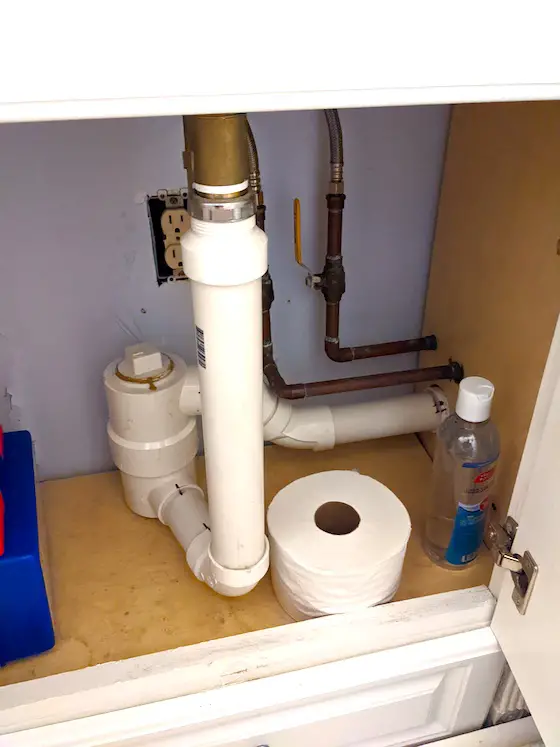Sewer Gas Dectector

Sewer Gas Detector | This is a p-trap although it’s a different design. This device, so long as it’s filled with water, stops sewer gas and vermin from entering your home. Copyright 2022 Tim Carter
Sewer Gas Detector - Read the Short Sewer Gas EBook First
Do you have the same problem I have with the passage of time? It’s hard to believe, but I’ve been a master plumber since 1981. I’ve always loved doing plumbing work because it’s a true three-dimensional puzzle.
You may not realize it but just after the US Civil War smart people finally connected disease and sickness to bacteria. All of a sudden it became quite apparent that it was a great idea to pipe body waste to remote parts of cities instead of throwing pans of it out second-story windows to splash on the street.
Plumbers all of a sudden became as respected as physicians because their skills working with pipes allowed people to stay healthy. This was true of both drain lines and the installation of potable water lines that provided fresh, clean, and sanitary water to millions of people.
To this day these facts are a primary driver why plumbers are well-paid. If you have a daughter, son, or grandchild that wants to have a rewarding career that provides significant income, point them to a trade school that teaches this craft.
It’s vital that plumbing drain pipes, as well as the vents that connect to them, be installed correctly so sewer gas never enters your home. Each week I solve sewer gas problems over the phone with homeowners just like you. In fact, yesterday I solved a vexing problem for a New Mexico homeowner just hours before he was expecting house guests.
Sewer gas can be found in septic tanks, city sewers, and the drain pipes in your home. It smells horrible. It’s caused by the decomposition of bodily waste and rotting food that you send down your drain pipes. It’s toxic and can cause severe illness if you’re exposed to enough of it for long periods of time.
Just two years ago a man hired me to come to his home to solve a sewer gas issue. His wife was seriously ill and no doctor could figure out the cause. Within minutes I connected her suffering to the leaking sewer gas. I found out that they had installed a new tile floor on top of an existing one in a powder room immediately adjacent to where his wife sat and watched TV.
After the new floor was installed, the tile setter or plumber didn’t put in an extra wax ring to account for the fact that the toilet now sat 1/2-inch higher than it did before the new floor was installed. Invisible sewer gas was leaking from the base of the toilet like smoke issuing from a raging wood-burning fireplace. As soon as two wax rings were installed on top of each other on the toilet flange and the toilet reset, the sewer gas stopped entering the home.
A year ago I decided to help homeowners like you solve sewer gas problems on your own. I decided to write a simple short book about sewer gas. It explains how your plumbing system works. I then ask you a series of questions that helps you narrow down why you’re having sewer gas issues. Within a few minutes you can normally figure it out on your own. If not, I can call you on the phone as I do with many many people each year.
Here are the basic things you need to know about your plumbing system and sewer gas. First, it’s vital the plumbing pipes in your home work like the blood vessels in your body. When all is well in your body, your blood stays inside the blood vessels. If you cut yourself or a vessel breaks under pressure, blood leaks out. The same is true for the pipes in your home. When all is well, the liquids, solids and sewer gas stay in the pipes.
But if a pipe cracks, has a hole drilled in it, or a trap under a fixture dries out, then sewer gas and vermin can enter your home. Dried-out p-traps under sinks, showers, and floor drains are the most common source of sewer gas.
Two years ago I did a phone consult with a man that owned a condo in a high-rise building in Monaco. He had a horrible sewer gas problem. It turns out the source of the leaking gas was in multiple other condo units above and below his unit!
Many of the condo owners only stay in their units for a few months out of a year and while they’re gone water evaporates from the traps under all the fixtures and from the toilet bowls. Once the water seal in the traps is broken, the sewer gas wafts into the unit and then enters the tall plumbing shaft where all the pipes go down to the street. The sewer gas in the tall shaft was getting into the man’s condo.
I had him contact the condo maintenance manager. He used his master key and went into each vacant condo. He then ran water in all the fixtures and flushed all the toilets. Within hours the sewer gas problem in the entire high-rise building stopped.
Wind can also cause a problem. That plumbing pipe up on your roof works the exact opposite of chimneys at factories. Chimneys are designed to get rid of smoke from a fire or furnace. Plumbing vent pipes do the opposite. They supply fresh air down into the pipes in your home each time you run water in a sink, shower, or flush a toilet.
If you want to read the first chapters of my short sewer gas book for FREE, go here.
Column 1464
2 Responses to Sewer Gas Dectector